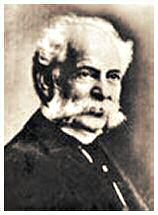
Henry
John
Heinz
Born:
Oct. 11, 1844
Died: May 14, 1919
Thursday, January 6, 2005
Page 15
REMINISCING (Column)
Heinz Mustard: a Product With an Uncertain History
By ROGER M. GRACE
“Heinz’s Tomato Ketchup is unexcelled; so is his prepared Mustard.”
A grocery store, Cooper and Gill, included that claim in its Nov. 19, 1897 ad in The Semi-Weekly Landmark, a newspaper in Statesville, North Carolina.
Heinz’s “mixed mustard,” as well as its “mustard dressing,” could be found on the shelves at E.A. Barnett’s store in Bedlord, Pa., as reflected by the June 1, 1900 issue of the Bedford Gazette.
These and other ads in pre-1904 newspapers debunk the boast by the makers of French’s Mustard that their product was the first “prepared mustard” (as opposed to mustard powder) on the market.
Timothy L. Gaus, the H.J. Heinz Company’s historian, said in an e-mail:
“We have unattributed documentation that shows Heinz producing prepared mustard in 1870, six years before we even began tomato ketchup. Our 1895 salesmen’s catalog does have prepared mustard, so we have proof as early as 1895. Our mustard was on the market well before French’s.”
It might well be that Henry John Heinz— or H.J. Heinz—was selling mustard in 1870. A born entrepreneur, he was, as a child, selling produce from the family garden to neighbors, later to grocers. After he became a bricklayer, he was peddling prepared horseradish as a sideline.
|
|
Henry
|
|
But if Henry Heinz was vending mustard in 1870, it was as a partner in Heinz & Noble. That company began operations the previous year when Heinz, 25, formed a partnership with a neighbor, L. Clarence Noble. The company produced horseradish and other products under the “Anchor Pickle and Vinegar Works” brand label. It became Heinz, Noble & Company in 1872 when E. J. Noble came aboard.
The H.J. Heinz Company of today, which dates back to 1876, has no tie to that venture (though, fudging, it appropriates its founding date of 1869). Heinz, Noble & Company went into bankruptcy in 1875. The following year, Henry Heinz began guiding a new, unrelated, prepared-foods company owned by his brother John and his cousin Frederick. In light of his bankruptcy, Henry Heinz was precluded from having an ownership interest in the new company. After he paid off his debts, however, he acquired controlling interest from his kin and the company was in 1888 redesignated the H.J. Heinz Pickle Company.
Just when it was that Heinz Mustard went on the market is unknown. This much is certain: it was before French’s (1904) and after Gulden’s (1862). Necessarily, the product being marketed today does not have roots earlier than 1876 when the Heinz company was founded.
Also unknown is the original taste or color of Heinz’s Mustard. One would assume it was brown and hearty, as prepared mustard typically was in the 19th Century. Today, it is yellow (from turmeric) and, like Morehouse and other yellow mustards, mild and indistinguishable from (that is, imitative of) “classic” French’s.
The Heinz company, in its early days, offered variations on its prepared mustard, long abandoned. An ad in the March 3, 1904 edition of the Atlanta Constitution shows that Heinz had expanded its product line to include a “Sweet French Mustard” and that he was selling the aforementioned “Mustard Dressing” in bottles. Both were priced, at Donnelly’s, at 15 cents.
|
|
|
Was Heinz’s Prepared Mustard among the original “57 Varieties”? Yes and no.
When Henry Heinz came up with his “57 Varieties” slogan, it was 1896, and his prepared mustard was among the company’s wares. But apparently, “57 Varieties” was a fanciful phrase not encompassing any particular products.
Heinz, as the story goes, was riding on an elevated train in New York one day when he spotted an ad for “21 varieties of shoes.” He thought it was catchy, and a few days later came up with “57 Varieties” as an advertising device, choosing that number because he liked the sound of it. At the time, he had more than 60 products.
Whether that’s so or not, the company did come to use the slogan in connection with 57 specified products.
On April 1, 1899, the Fitchburg (Mass.) Sentinel carried an ad placed by a grocery store announcing that on April 15, two Heinz representatives would demonstrate “57 varieties of their products, each one first-class.”
A 1923 ad in The American Magazine listed the company’s 57 varieties. Prepared mustard was #49.
|
|
|
The products were of a disparate nature—ranging from baked beans to mince meat to fig pudding—so they weren’t really “varieties” of any particular food. But the term “57 Varieties” was, and is, effective as an attention-grabber even in these days when Heinz boasts ownership of 1,300 products worldwide.
|
|
|
Copyright 2005, Metropolitan News Company